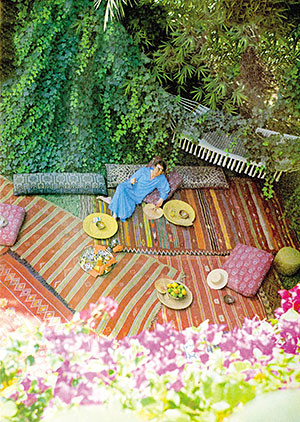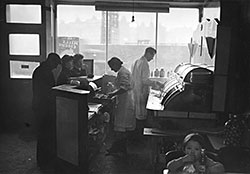How Horst P Horst captured the inside world of the rich and famous

Simply sign up to the Life & Arts myFT Digest -- delivered directly to your inbox.
Few photographers of interior design have greater mythic status than Horst P Horst, and no decoration book is more lusted after than his extraordinary 1965 volume, Vogue’s Book of Houses, Gardens, People, itself a collection of myths.
Horst’s very name was something of a fabrication: he was born in 1906 into a successful German mercantile family as Horst Paul Albert Bohrmann but after moving to Paris aged 23 decided to change his name. Having trained as an architect, he worked for Le Corbusier before entering the world of Parisian high fashion, aided no doubt by his good looks and charm, and a number of influential male admirers, and lovers. In the late 1930s he moved to New York, cementing his reputation as the most glamorous of 20th century photographers. His career spanned 60 years and is the subject of a major retrospective at the V&A in London.
The same sense of invention that we see throughout his life provides a clue to a man who was to create, in the pages of 1960s Vogue, under the editorship of legendary Diana Vreeland, a contrived yet perceptively truthful image of the rich in their houses that has lingered in the popular imagination for 50 years.
Horst’s interior photography shows a world that he at once belonged to and was remote from: of Pauline de Rothschild and the Duke and Duchess of Windsor, of English aristocracy and American supremacy. His partner for many decades, diplomat and upper-class Englishman Valentine Lawford, was as well connected as Vreeland herself, and he and Horst were invited into many houses that were featured in the magazine not only as mere spectators but as friends. Lawford always wrote the essays accompanying the Vogue articles; his long, elegantly written prose descriptions are as fanciful a reflection of their subjects as Horst’s photographs, often breathless in their praise yet with a perceptive undertone to each.
Horst’s subjects are at ease with him and he with them. Through his lens, we see the rich, powerful or artistic – “the beautiful people” as Vreeland called them – relaxing in their own spaces, smiling, apparently unaware at all of the immortality that Horst’s all-seeing camera was to bestow upon them, and equally appear unaware of their often staggering wealth and privilege.
Each page of these richly coloured stories is suffused with a powerful sense of beauty – both of surroundings, and in many cases, of their owners. The ravishing faces of young Lord and Lady Elliot at their country house, Port Elliot in Cornwall, the piercing blue Mitford eyes of Desmond Guinness and his family, at Leixlip Castle in Ireland, Yves Saint Laurent at his retreat in Marrakech, and the youthful Mr and Mrs Carter Burden Jr, all dominate the pages as much as the serene interiors that surround them.

Houses, Gardens, People forms an inseparable trinity. It is unlikely, today, in a world where images and information are so freely available and so readily distorted, and where privacy, for the truly rich, is far more valuable than publicity, that a photographer like Horst could even exist. It is impossible to imagine our equivalent of the Windsors, Consuelo Vanderlbilt Balsan, the Rothschilds or the Cy Twomblys opening their doors the way they did with Horst. Condé Nast’s other famous title, The World of Interiors, may show us places that other magazines cannot reach (The Prince of Wales’s apartments at Clarence House, for instance) but these images are purely of interiors, the owners firmly absent. Horst’s photographs for 1960s Vogue are really all about the people in their places.
“Few things,” writes Vreeland in her foreword to the book, “are more fascinating than the opportunity to see how other people live during their private hours – in the rooms they love, in the gardens they have planted, among their personal possessions, pursuing their favourite interests, enjoying their special comforts, organising their domestic arrangements to fit the pattern of their individual lives.”
Many of Horst’s photographs are shot through softly focused foreground flowers, or candlesticks, silver or glass, as if to impart a mood of artlessness. We just happen to be here, looking in at this world, Horst seems to say: enjoy it while it lasts. Perhaps it is this sense of fragility that makes Houses, Gardens, People so poignant and enduring. There is the quality of the hastily taken image that belies the extent to which Horst composed his interior photographs, often rearranging furniture and entire rooms. Do we find here something of the mood of the voyeur of our own age, artist Alison Jackson, who goes to extraordinary lengths, with the help of celebrity lookalikes, to create views that look utterly casual? Maybe – but while Jackson’s subjects are fake, Horst’s are real.
One of his favourite portraits was of the Duke of Windsor, photographed in an essay on the Duke and Duchess and their house in the Bois de Boulogne, Paris. That photograph was a lucky chance – Horst snapped the image and in an instant captured myriad emotions on that troubled, handsome face. Horst’s portrait of the Duchess is more composed. It is taken indoors, in the library, in the evening on a beautiful “yellow-silk sofa in an alcove lined with orange-yellow velvet”, as Lawford describes it. The interior, here, is a fundamental part of the image.
The interior design captured in Horst’s photographs is of superb quality. Each house is as unique as its owner but as a complete collection there are similarities running through the whole. Each has achieved a certain level of nonchalant perfection. Some are famous in their own right: Nancy Lancaster’s interiors at Haseley Court near Oxford demonstrate why Colefax and Fowler, the English decoration firm she part owned, remained the sine qua non of country house decoration for decades. The artist Cy Twombly’s palazzo in Rome shows how his lucid, grey-white paintings, with delicate dabs of plum and lemon, merge almost seamlessly with his personal sense of interior design. The artist’s reputation has grown exponentially in the decades since the publication of Horst’s photographs.
Many houses show the burden of having to spend money for the sake of it: Baroness Geoffroy de Waldner, who lived at La Grange in Mortefontaine, is described as an obsessive gardener. “Her love of gardening,” writes Lawford, “is not a form of escapism, since she is unaware of the need to escape.” The images show the garden being prepared for a party, with giant ladybirds formed of red carnations and black cornflowers dotted around the place for no reason other than they appear to be a recurring theme of her life.
Horst’s photographs and Lawford’s essays describe a world that feels on the brink of being shut down. Glen Adamson, writing in the beautiful illustrated catalogue of the V&A exhibition, touches eloquently on this fragility. “The style of the patrician class . . . was a source of inspiration, yet they also knew this world of closed, cosmopolitan refinement was not built to last. A light shines through it – as if through the cracks in the edifice of aristocracy”.
Looking at the brittle, beautiful images Horst produced for Vogue, it is impossible not to feel the sense of a moment passing. Barely is there a hint of the Vietnam war, or the civil rights movement, yet the clarion call of social upheaval was ringing at precisely the moment when Horst was creating these images. Of Mrs Samuel Reed, Lawford was to write that her profile “once might have fetched its possessor to the guillotine”. The next time such huge wealth was to dominate the headlines is our own. While the symbiotic cord between art and money seems stronger than ever, the relationship between taste and money, which Horst so eloquently made his own, might have passed forever.
‘Horst: Photographer of style’ runs at the V&A in London until January 4, 2015
Ben Pentreath is an architectural and interior designer
——————————————-
British buildings in sharp focus

If Horst is the ultimate pan-European/American photographer, whose subject matter knew few boundaries except class, money, art and taste, then a second exhibition on display in London this autumn provides a fascinating counterpoint to the V&A show.
Ordinary Beauty: The Photography of Edwin Smith, at the Royal Institute of British Architects – which holds the archive of Smith’s work – is a major retrospective of this most English of photographers.
During the 1950s and 1960s Smith (1912-1971) produced an astonishing amount of superbly crafted and composed black-and-white photographs, making his subject matter the vernacular of British towns and countryside.
People feature rarely, either to provide scale to a monumental building, or as the heroic, ordinary citizens of this landscape – be they young children on a street of cottages in Ireland or station platform crowds.
His greatest works are of the buildings and interiors of rural England, described with a poetic quality.

Smith had no exhibition of his work in his lifetime and the first monograph of his work appeared only in 1984.
The exhibition at RIBA, which runs until December 6, is dedicated to Robert Elwall, curator of the RIBA Photographs Collection for 36 years, who did so much to generate a greater appreciation of Smith’s work.
Photographs: Horst/ Vogue/ Condé Nast; Edwin Smith/ RIBA
Comments